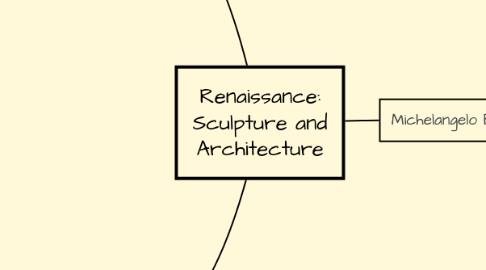
1. How sculpture changed
1.1. Statues lifelike
1.2. Statues free standing, not part of buildings
1.3. Copied Greek and Roman, realistic
1.4. Dissected bodies for accuracy
1.5. Nude
2. Michelangelo Buonarotti
2.1. Background
2.1.1. Born Florence, 1475
2.1.2. 13 years old apprenticed
2.1.3. Made copy of Roman statue, seen by Lorenzo de Medici
2.1.4. Invited to his school
2.2. Pietà
2.2.1. After Lorenzo died
2.2.2. Mary holding Jesus
2.2.3. Means "sorrow"
2.2.4. Only statue signed
2.3. David
2.3.1. War between Florence and France
2.3.2. Town held competition to celebrate victory
2.3.3. Reminded him of David and Goliath from bible
2.4. In Rome
2.4.1. Pope Julius II
2.4.2. Hired him to paint frescoes on the Sistine Chapel
2.4.3. Four years, told story of creation
2.4.4. Became so involved in painting, forgot eating and sleeping
2.4.5. When old, painted fresco on wall called "The Last Judgement"
2.5. Poet and Architect
2.5.1. 300 love poems
2.5.2. Most sonnets
2.5.3. Some of best in Italian
2.5.4. Designed dome of St Peter's Basilica
2.5.5. Laurentian Library in Florence
2.5.6. Almost 90 when died
2.5.7. Never married, art was his child
3. How architecture change
3.1. As opposed to Gothic style
3.1.1. Round arches not pointed arches
3.1.2. More symmetry
3.1.3. Spires turned to domes
3.1.4. Pediments and columns instead of flying buttresses
3.2. Developments
3.2.1. Domes
3.2.1.1. Filipo Brunelleschi
3.2.1.2. Studied Roman buildings, especially Pantheon
3.2.1.3. First build on Florentine cathedral
3.2.1.4. 16 years to complete
3.2.2. Symmetry
3.2.2.1. Exact symmetrical plan
3.2.2.2. Had to have same amount of windows and arches
3.2.3. Round arches
3.2.3.1. Hugely popular
3.2.3.2. Decorated buildings and support
3.2.4. Pediments and columns
3.2.4.1. Originally Roman
3.2.4.2. Andrea Palladio made Palladian style
3.2.4.3. Designed 150 houses for wealthy Italians
